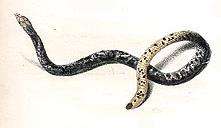Rhinophis
Rhinophis is a genus of nonvenomous shield tail snakes found in Sri Lanka and South India. Currently, 19 species (with no subspecies) are recognized in this genus.[2] Of the 19 species, 15 are endemic to Sri Lanka, while 4 are endemic to South India.
| Rhinophis | |
|---|---|
 | |
| Bloody-bellied earth snake, R. sanguineus | |
| Scientific classification | |
| Kingdom: | Animalia |
| Phylum: | Chordata |
| Class: | Reptilia |
| Order: | Squamata |
| Suborder: | Serpentes |
| Family: | Uropeltidae |
| Genus: | Rhinophis Hemprich, 1820 |
| Synonyms | |
- Common names:Shield tail snakes
Geographic range
Found mainly in Sri Lanka and also in southern India. In Sri Lanka, this genus also occurs in low plains in the dry zone.[1]
Species
| Species[2] | Taxon author[2] | Common name | Geographic range[1] |
|---|---|---|---|
| Rhinophis blythii | Kelaart, 1853 | Blyth's shield tail snake | Sri Lanka in the hills of Central (Hatton and Pundluoya), Uva, Sabaragamuwa (Balangoda) and Southern Provinces. |
| Rhinophis dorsimaculatus | Deraniyagala, 1941 | Polka-dot earth snake[3] | Sri Lanka. Known only from the type locality in North Western Province. |
| Rhinophis drummondhayi | Wall, 1921 | Drummond-Hay's shield tail snake | Sri Lanka in the Hills of Central and Uva Provinces (Haldumulla, Nanunukula and Uva Patnas at 1,200 m elevation). |
| Rhinophis erangaviraji | Wickramasinghe et. al., 2009 | Eranga Viraj's shield tail snake | Sri Lanka. |
| Rhinophis fergusonianus | Boulenger, 1896 | Cardamom Hills shield tail snake | Southern India in the Western Ghats: Cardamom Hills, Travancore. |
| Rhinophis goweri | Aengals & Ganesh, 2013 | Gower's shield tail snake[3] | Eastern Ghats of Tamil Nadu in Bodha Malai Hills of Namakkal district. |
| Rhinophis homolepis | (Hemprich, 1820) | Trevelyan's shield tail snake[3] | Sri Lanka in the Hills of Sabaragamuwa (Ratnapura, Yatiyantota and Balangoda Hills below 900 m), Central and Uva Provinces. |
| Rhinophis lineatus | Gower & Maduwage, 2011[4] | striped Rhinophis | Sri Lanka |
| Rhinophis melanogaster | (Gray, 1858) | Gray's shield tail snake | Sri Lanka |
| Rhinophis oxyrynchusT | (Schneider, 1801) | Schneider's shield tail snake | Sri Lanka in the dry zone of Northern, Central and Eastern Provinces. |
| Rhinophis philippinus | (Cuvier, 1829) | Peter's shield tail snake | Sri Lanka in the Hills of Sabaragamuwa and Central Provinces. |
| Rhinopis phillipsi | (Nicholls, 1929) | Phillips' shield tail snake | Sri Lanka |
| Rhinophis porrectus | Wall, 1921 | Willey's shield tail snake | Sri Lanka. Known only from the type locality in North Western Province. |
| Rhinophis punctatus | J.P. Müller, 1832 | Müller's shield tail snake | Sri Lanka in Central (Kandy, Peradeniya) and Western Provinces (Puttalam). |
| Rhinophis roshanpererai | Wickramasinghe et. al., 2017[5] | Roshan Perera's shield tail snake | Sri Lanka from central hills around Badulla |
| Rhinophis saffragamus | (Kelaart, 1853) | Large shield tail snake | Sri Lanka |
| Rhinophis sanguineus | Beddome, 1863 | Bloody-bellied shield tail snake | Southern India in the Western Ghats: Mysore (Koppa, Kalsa), Waynad, Nilgiris, Travancore and Tinnevelly Hills. |
| Rhinophis travancoricus | Boulenger, 1893 | Travancore shield tail snake | Southern India: Travancore, from sea level to an elevation of about 1,200 m in the hills. In Trivandrum, Peermade, Mahendragiri, Ernakulam and Chenganacherry. |
| Rhinophis tricoloratus | Deraniyagala, 1975 | Deraniyagala's shild tail snake | Sri Lanka. Known only from the type locality: "vicinity of the rain forest of Sinha Raja to the south west of Ratnapura at an elevation of 1,500 feet with a rainfall of over 200 inches per annum. |
| Rhinophis zigzag | Gower & Maduwage, 2011[4] | Zigzag shield tail snake | Sri Lanka |
*) Not including the nominate subspecies.
T) Type species.[1]
gollark: I mean, slaves are *capable* of it, but the slavery paradigm doesn't allow for it.
gollark: The trouble is that you probably also need people to do, well, thinky stuff, which slaves can't really manage. If you want your slaves to be able to give you nice things like cars and smartphones.
gollark: Although if you want to maintain good current quality of life for *you* via slavery you'll need most of this infrastructure anyway.
gollark: Since nowhere has ALL the stuff you need you need a ton of transportation.
gollark: But then you have to locate factories in places with the right minerals.
References
- McDiarmid RW, Campbell JA, Touré T. 1999. Snake Species of the World: A Taxonomic and Geographic Reference, vol. 1. Herpetologists' League. 511 pp. ISBN 1-893777-00-6 (series). ISBN 1-893777-01-4 (volume).
- "Rhinophis". Integrated Taxonomic Information System. Retrieved 1 September 2007.
- The Reptile Database. www.reptile-database.org.
- Gower, D.J.; Mduwage, K. (2011). "Two new species of Rhinophis Hemprich (Serpentes: Uropeltidae) from Sri Lanka" (PDF). Zootaxa. 2881: 51–68.
- "A New Species of Rhinophis Hemprich, 1820 (Serpentes: Uropeltidae) from the central hills of Sri Lanka". Zootaxa. Retrieved 18 June 2017.
External links
| Wikimedia Commons has media related to Rhinophis. |
- Rhinophis at the Reptarium.cz Reptile Database. Accessed 1 September 2007.
- Aengals, R.; S. R. Ganesh 2013. Rhinophis goweri — A New Species of Shieldtail Snake from the Southern Eastern Ghats, India. Russ. J. Herpetol. 20 (1): 61-65.
- Ganesh, S. R. 2015. Shieldtail snakes (Reptilia: Uropeltidae)– the Darwin's finches of south Indian snake fauna? Manual on Identification and Preparation of Keys of Snakes with Special Reference to their Venomous Nature in India., Govt. Arts College, Ooty, 13-24.
- Pyron, R. A., Ganesh, S. R., Sayyed, A., Sharma, V., Wallach, V., & Somaweera, R. 2016. A catalogue and systematic overview of the shield-tailed snakes (Serpentes: Uropeltidae). Zoosystema, 38(4), 453-506.
This article is issued from Wikipedia. The text is licensed under Creative Commons - Attribution - Sharealike. Additional terms may apply for the media files.